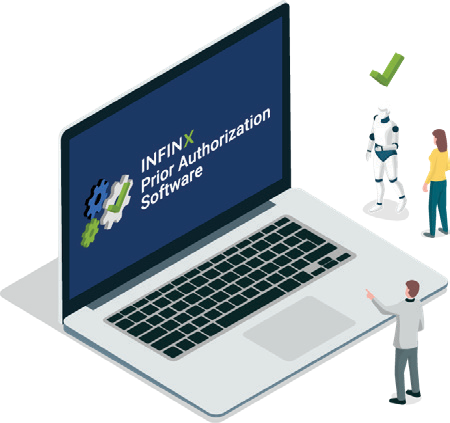COVID-19: RCM Frequently Asked Questions

General
How long are emergency provisions through the COVID-19 Public Health Emergency (PHE) Declaration in effect?
Effective July 20, 2021, Health and Human Services (HHS) has extended the public health emergency (PHE) for at least 90 days and with the severity of the DELTA variant on COVID-19 numbers, there is every indication that the PHE will be extended further.
Currently, individual states are determining COVID-19 emergency orders with various end dates. Please see a state-by-state summary and more here.
Are there new codes for vaccines and vaccine administration?
On September 7, 2021, the American Medical Association (AMA) announced new codes for vaccine booster shots and administration, as well as codes for the new Pfizer vaccine formulation that features a tris-sucrose buffer instead of the phosphate buffer from the original vaccines. Click here for new code updates.
CMS also recently implemented 21 new ICD-10-PCS codes for vaccines and therapeutics, including FDA-approved baricitinib, currently used for rheumatoid arthritis (brand name Olumiant), and when used for inpatient treatment and in conjunction with remdesivir, as well as monoclonal antibody and immunomodulator treatments.
Additionally in 2021, CMS assigned Medicare Severity Diagnosis-Related Groups (MS-DRGs) to new six ICD-10-PCS codes related to COVID-19 for inpatient care.
For inpatient care, CMS has approved using the CPT code for vaccines and vaccine administration for all inpatients. Medicare Advantage participants should have claims submitted to Original Medicare for all vaccines and vaccine administration through 2021.
On November 10, 2020, the AMA released new codes for the vaccine (91300 – Pfizer and 91301 – Moderna), as well as new administration codes (0001A, 0002A, 0011A, and 0012A). And on September 7, 2021, new codes were released for vaccine booster shots and their administration.
Additionally, the AMA released new CPT codes for the COVID-19 vaccine from AstraZeneca and the University of Oxford, as well as from Janssen. The codes were conceived and approved in anticipation of vaccine approval sometime in early 2021. Click here for code information.
Are there new codes for monoclonal antibody treatments?
Beginning 11/10/20, the Centers for Medicare and Medicaid Services (CMS) initiated new codes for COVID-19 Monoclonal Antibodies and their administration during the public health emergency. Click here for code information.
How do we treat out-of-pocket costs, including co-payments and deductibles, for COVID-19 testing or treatment?
Effective March 6, 2020, Medicare and most commercial insurers waived cost sharing for laboratory testing, as well as treatment and care, for COVID-19 patients (Medicare Part B). In addition, many commercial payers waived all telehealth coinsurance fees for COVID-19 and non-COVID-19 patient encounters.
However, as of August 27, 2021, most insurance companies have resumed cost sharing and discontinued their PHE waiving of fees.
Are there codes specific to the new COVID-19 vaccine? Administration?
Yes, most recently, the AMA released codes for vaccine booster shots and their administration on September 7, 2021. The codes and long descriptions for all COVID-19 changes or additions are included here.
Has a reimbursement price been determined for vaccines and their subsequent administration?
Effective October 28, 2020, CMS issued a rule stating that they will reimburse $28.39 for the administration of a single dose of COVID-19 vaccine. If the vaccine turns out to require multiple doses, CMS will pay $16.94 for the initial doses and $28.39 for the last dose of the series. Commercial insurance is expected to follow suit. There will be no cost to patients.
When there is a vaccine, has a price been determined?
Effective October 28, 2020, Centers for Medicare and Medicaid Services (CMS) issued a rule stating that they will pay $28.39 for the administration of a single dose of COVID-19 vaccine. If the vaccine turns out to require multiple doses, CMS will pay $16.94 for the initial doses and $28.39 for the last dose of the series. Commercial insurance is expected to follow suit.
Who does the new cost-sharing waiver impact?
Waived cost-sharing applies to testing and treatment rendered in the following types of facilities:
- Physicians and paraprofessionals paid under a Physician Fee Schedule
- Critical Access Hospitals (CAHs)
- Hospital Outpatient Departments paid under the Outpatient Prospective Payment System
- Federally-Qualified Health Clinics (FQHCs)
- Rural Health Centers (RHCs)
Does the cost-sharing waiver apply to Medicare Part A?
No, CMS is excluding the cost-sharing waiver for Medicare Part A and inpatient treatment associated with COVID-19. However most commercial carriers are waiving costs for all COVID-19 care including inpatient copays and treatment costs.
Our hospital has established overflow outpatient care in alternative sites outside the facility. How should care be billed for Point of Service (POS) and with what CPT codes?
First, when expanding care capacity, the hospital must meet the emergency Conditions of Participation in effect during the PHE when operating temporary expansion sites including operating in a manner consistent with its state’s emergency preparedness plan. POS would be 19 – Off Campus-Outpatient Hospital or 20 – Urgent Care Facility using CPT codes appropriate for the services performed.
In terms of ICD-10-CM code sequencing, how should we treat COVID-19?
When COVID-19 meets the definition of a first-listed or principal diagnosis, use code U07.1, sequenced first and followed by the appropriate associated conditions. For example, when a patient presents with respiratory failure associated with confirmed COVID-19, U07.1 would be sequenced first, followed by J96.90 – respiratory failure.
Is there a code that recognizes the additional supplies and staff time needed to properly clean and sanitize space and equipment?
On September 8, 2020, the AMA added a new code for COVID-19 billing. CPT code 99072 is intended to recognize additional supplies and clinical staff time being used to contain and stop the coronavirus.
This code should only be used once per in-office visit (not for each procedure performed) and only during a public health emergency. It can be used in addition to code 99070 which denotes regular supplies and materials.

Laboratory Testing
Have there been any pertinent updates to coding for antigen testing?
Yes, on Friday, June 26, 2020, the AMA added new code 87426 to specify billing of antigen tests performed on patients suspected of being infected with coronavirus. The AMA has already developed and approved CPT codes for other serological tests for COVID-19 antibodies, including 86328 and 86769.
Other codes already exist to report coronavirus; can those codes be used specifically for COVID-19?
No, the new code 87635 is specific to SARS-CoV-2 (COVID-19) and should be used for infectious detection of a suspected severe acute respiratory syndrome coronavirus 2. Other codes (i.e., 87631, 87632, 87633, 0098U, 0099U, and 0100U) are still appropriate for identifying other respiratory pathogens.
Is reporting COVID-19 testing treated differently if other services are performed on the same date?
No, other services should be reported per CPT guidelines, in addition to code 87635.
Often both nasopharyngeal and oropharyngeal swabs are submitted for a patient for initial diagnostic testing. How should this be coded?
Use 87635 and a second code of 87635 appended with the modifier 59, Distinct Procedural Service, to report that results represent a separate service performed.
Is there a special specimen collection code to be used by physician offices when swabbing for COVID-19 testing?
Code 99000 should be used when a specimen is collected as part of an actual visit and is not paid by most insurance payers. However, on April 30, 2020, CMS clarified that, through the duration of the PHE, code 99211 – Level 1 E/M Visit (or nurse visit) can be used when a specimen is collected for screening purposes and when not associated with a doctor’s visit. This allows providers to be reimbursed for providing a screening location or drive-through testing for COVID-19.
Can an urgent care center, physician’s office, or hospital lab bill the G2023 or G2024 specimen collection code?
No, these HCPCS specimen collection codes were developed specifically for independent clinical laboratories.
Are codes U0003 and U0004 to be used when utilizing rapid testing procedures for suspected COVID-19 patients?
Yes, as better testing has been developed utilizing high throughput technology, the CPT codes were amended to include these specific codes to reflect advanced testing. On April 27, 2020, CMS agreed to increase the reimbursement for tests coded with high-throughput technology at $100. Most commercial carriers are matching CMS at this time.
When documented as a presumptive positive COVID-19 case, can we code as such without a positive CDC-confirmed result?
Yes, CDC confirmation is no longer required. Presumptive positive COVID-19 tests are tests that have not been confirmed by the Centers for Disease Control and Prevention (CDC), but have tested positive by local or state labs and should be coded as positive.
Are there new CPT codes being issued by the AMA?
Yes, on September 7, 2021, the AMA published additional updated codes pertaining to COVID-19. The changes include additions for Pfizer and Moderna vaccine booster shots and administration. All subsequent COVID-related codes and long descriptions are available here.

Telehealth Services
Are telehealth services not related to COVID-19 billed as an office visit?
Effective March 6, 2020, and continuing through the duration of the PHE, Medicare and most commercial insurers will pay at the same contracted rate as in-office visits for telehealth services whether related to COVID-19 or not. On May 1, 2020, that list was further updated and clarified to include a wide range of specific treatment management areas. As of January 1, 2021, all telehealth-related changes will be permanent.
So how do we code a physician’s visit performed via telehealth?
For telehealth services, use E/M office visit codes (99201-00205 for new patients and 99211–99215 for established patients) as you would for in-office care. Attach a -CS modifier to indicate the service is eligible for Cost Sharing Waiver and use a POS code of 95 to denote services provided at a remote location. These services will be paid at the current fee schedule and patients are not responsible for associated cost sharing through copays and codeductibles.
Has CMS raised the reimbursement for audio-only telephone services?
CMS is increasing payment for audio-only telephone E/M services (CPT codes 99441-99443) such that they are paid at the same rate as similar office and outpatient E/M visits, resulting in increased payments from $14-$41 to $46-$110 per visit.
Are there any changes to charting or documentation expectations for telehealth encounters? Or compliance and HIPAA?
Charting and documentation is the same as with an in-person visit, but should also include a statement describing the way the service was provided (i.e., type of technology used), the location of the provider, and all people involved in the visit. If conducted from home, the provider does not have to divulge his or her home address; the business address will suffice for insurance reporting purposes.
In terms of regulatory compliance, the Office of Civil Rights (OCR) expects that healthcare providers will exercise appropriate discretion when conducting telehealth visits, i.e., use of a private setting, foregoing speaker phones, lowering voices, etc. Providers are expected to implement reasonable HIPAA safeguards to shield protected health information (PHI). Verbal consent for treatment is required to be documented at each visit.
When are telephone services not billable as telehealth?
Do not bill in these situations:
- Call results in a decision for the patient to be seen within the next 24-hour period; it’s then considered pre-service
work prior to care or treatment - If there has been an E/M service provided within the previous seven days
- When a follow-up call is performed within the postoperative period of any completed procedure
- Codes 99441-99443 have been billed in the previous seven days (by the same provider)
When do we use the 99421-99423 vs. E/M codes for either new or established patients?
CPT E/M codes are used when the visit is in real-time, has an audio and video component, and are between the provider and the patient. Codes 99421-99423 are used for online digital evaluation and management services that are non-face-to-face, patient-initiated, through digital communications, such as a patient portal, and require clinical decision making as is usually provided in the office.
- Reducing Provider and Patient Burden by Improving Prior Authorization Processes, and Promoting Patients’ Electronic Access to Health Information. Health Informatics and Interoperability Group, Centers for Medicare & Medicaid Services, CMS.gov. January 15, 2021.
https://www.cms.gov/Regulations-and-Guidance/Guidance/Interoperability/index.
Accessed on January 15, 2021. - 2019 CAQH Index, Conducting Electronic Business Transactions: Why Greater Harmonization Across the Industry is Needed. CA QH Explorations. 2020.
https://www.caqh.org/.
Accessed on January 30, 2020. - Siwicki, B. At RadNet, AI-Fueled Prior Authorization Tech Shows Promise. Healthcare IT News, Global Edition, Imaging. May 6, 2019. https://www.healthcareitnews.com/news/radnet-ai-fueled-prior-authorization-tech-99-accurate.
Accessed August 2, 2020. - Ibid. 2.
- Napco’s iBridge Technology Named Top Innovation of 2014 by Security Sales & Integration Magazine – Recurring Revenue Model Makes iBridge a Top Choice for Security Dealers. January 13, 2015.
https://investor.napcosecurity.com/2015-01-13-NAPCOs-iBridge-Technology-Named-Top-Innovation-of-2014-by-Security-Sales-Integration-Magazine.
Accessed on February 3, 2020. - Integrating Prior Authorization Solution with Epic PMS While Protecting PHI at a Pennsylvania Hospital Group. Infinx Case Study. 2018. https://www.infinx.com/resource-casestudy/integrating-preauthorization-solution-with-epic-pms-lt/
Accessed on February 2, 2020. - Diesing, G. A Pathway to Clinical and Administrative Data Integration, Health Data Features. Journal of the American Health Information Management Association (AHIMA). September 8, 2020.
https://journal.ahima.org/a-pathway-to-clinical-and-administrative-data-integration/.
Accessed on September 16, 2020.
About Infinx
Infinx provides innovative and scalable payment lifecycle solutions for healthcare practices. Combining an intelligent, cloud-based platform driven by artificial intelligence and automation, with our trained and certified prior authorization, coding and billing specialists, we help clients realize revenue, enabling them to shift focus from administrative details to billable patient care.

